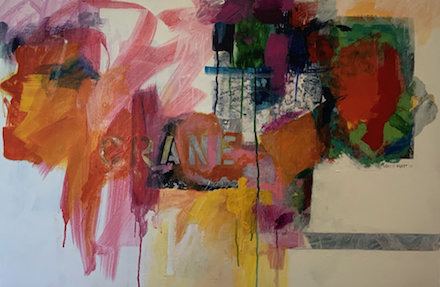
|
|
|
|
|
| Issue 5: | October 2020 |
| Tanka Prose: | 369 words |
By Charles D. Tarlton
Crane by Ann Knickerbocker

Copyrighted © by Ann Knickerbocker. All rights reserved.1
Brushed up by brushy winds in brushy clouds,
Wetted by blue, colder for white.
—Wallace Stevens 2
What do we know about “Ann Knickerbocker” who made this picture? A woman schooled in beauty, sure, a lover of color and shape and the magic of making them move. But an intuitive spirit, too, who makes spontaneous gestures with knife and brush, who slathers on delicate colors and lets them run off to their own conclusion. There is a wild energy layered here over a more complicated and geometric substructure positioned to hold things together. My question is: who could think up such stuff, challenging her own inner structure with a moment’s wild slashing of pink?
pink? did you say pink?
where’s the Crane? out in the middle
of the morning marsh
there with the nesting Osprey
the high gray sea, the shoreline
Louis Vuitton! Tucked
away, distanced in disappointment
the tiniest portion
a metaphor for the unattainable
something pink escaping
the Crane’s a white bird
whose curvature is the dead queen’s
crown, and they stood before her
stood before the muddy hogan
the poem in its metaphor
Look how the paint goes on! Cool and deliberate here, underneath unquestioned madness, swirls and daubs pushed hard and harder, bending the thickened bristles, pushing the paint out and in, one virtually straight line, and then several of them, patches, and smears of paint yearning to be squares or circles, lusting for their lost geometry. “CRANE” defies and organizes all this at the same time. The Crane, like Herons and Egrets that come in sieges, an elegant water bird, white with a long, curved neck. Or, maybe she meant industrial cranes, huge lifting wound-cabled structures resembling children’s toys.
where they load and unload
freighters at the Port of Oakland
or Southampton, the big white
cranes on long legs looking
like mechanical seabirds
we’ve seen them perched
on the top of tall buildings
on barges in the river
digging channels for giant liners
to come all the way to town
she craned forward, her white neck
arched, and with a long paint-filled
brush she whirled on the pink
in a wild gesture, a kind of dance
her painterly grand jeté
Publisher’s Notes:
1. Crane (mixed-media painting, July 2020) by abstract artist Ann Knickerbocker
may also be viewed at her
online gallery.
2. Epigraph is from Part VI of “It Must Be Abstract” in the long poem
Notes Toward a Supreme Fiction (Cummington Press, 1942) by Wallace Stevens
(1879–1955).
Ann Knickerbocker
Please visit www.annknickerbocker.com for details about the artist, as well as links to her galleries and her blog Artist in an A-frame.
Charles D. Tarlton
is a retired university professor of political theory who lives in Old Saybrook, Connecticut with his wife, Ann Knickerbocker, an abstract painter, and a Standard Poodle named Nikki. He is the author of three books of prosimetra published by KYSO Flash Press: Touching Fire: New and Selected Ekphrastic Prosimetra (2018), Get Up and Dance (2019), and Carmody & Blight: The Dialogues (2019).
He also has a poetry e-chapbook published in the 2River series, La Vida de Piedra y de Palabra: Improvisations on Pablo Neruda’s Macchu Picchu; an experimental prosimetrum in Lacuna entitled Five Episodes in the Navajo Degradation; “The Rock in a Jar,” an extended prose poem in several parts in Gone Law 32; and “The Turn of Art,” a short prosimetrical drama pitting Picasso against Matisse, in Fiction International.
Tarlton has been writing poetry and flash fiction since 2006, and his work is published in: Abramelin, Atlas Poetica, Barnwood, Blackbox Manifold (UK), Blue and Yellow Dog, Book Ends Review, Clackamas Literary Review, Contemporary Haibun Online, Cricket Online Review, Dark Matter, Fiction International, Haibun Today, Ilanot Review, Inner Art Journal, Innisfree Poetry Journal, Jack Magazine, KYSO Flash, Linden Avenue Literary Journal, London Grip, Muse India, Palette Poetry, Peacock Journal, Prune Juice, Randomly Accessed Poetics, Rattle, Red Booth Review, Red Lights, Review Americana, Ribbons, Shampoo, Shot Glass, Simply Haiku, Six Minute Magazine, Sketchbook, Skylark, Spirit Wind Gallery, Tallow Eider Quarterly, The American Aesthetic, The Ekphrastic Review, The Houston Literary Review, tinywords, Tipton, Unbroken Journal, Undertow Tanka Review, and Ink, Sweat, and Tears.
More on the Web: By, About, and Beyond
⚡ Artifact With Steam (2019) by Ann Knickerbocker, ekphrastic tanka prose in the e-collection Get Up and Dance featured in KYSO Flash (Issue 12, Summer 20189)
⚡ Featured Author Charles D. Tarlton, with six of his ekphrastic tanka prose and an interview with Jack Cooper, in KYSO Flash (Issue 6, Fall 2016)
⚡ Notes for a Theory of Tanka Prose: Ekphrasis and Abstract Art, a scholarly paper by Tarlton residing in PDF at Ray’s Web; originally published in Atlas Poetica (Number 23, pages 87-95)
⚡ Three American Civil War Photographs: Ekphrasis by Tarlton in Review Americana (Spring 2016)
⚡ Simple Tanka Prose for the Seasons, a quartet by Tarlton in Rattle (Issue 47: Tribute to Japanese Forms, Spring 2015)
| Copyright © 2019-2026 by MacQueen’s Quinterly and by those whose works appear here. | |
| Logo and website designed and built by Clare MacQueen; copyrighted © 2019-2026. | |
|
Data collection, storage, assimilation, or interpretation of this publication, in whole or in part, for the purpose of AI training are expressly forbidden, no exceptions. |
At MacQ, we take your privacy seriously. We do not collect, sell, rent, or exchange your name and email address, or any other information about you, to third parties for marketing purposes. When you contact us, we will use your name and email address only in order to respond to your questions, comments, etc.